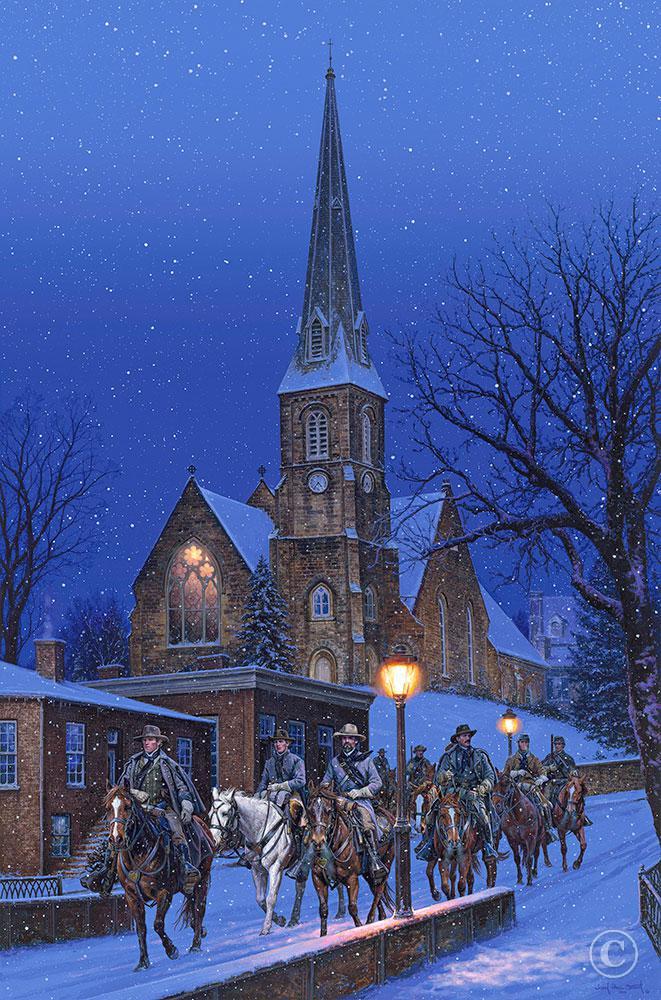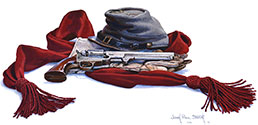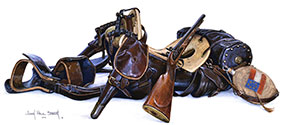THE GREAT CUMBERLAND RAIDMcNeill's RangersJohn B. Fay, Lt. Jesse McNeill, Lt. Isaac S. Welton, Sgt. Joseph W. Kuykendall, Erasmus Tucker, C. Ritchie Hallar, Sgt. Joseph L. Vandiver Emmanuel Episcopal Church - Cumberland, Maryland - February 21, 1865 
On the night of February 21, 1865 a heavy snow storm blanketed the countryside of Western Virginia and Maryland. Although difficult to travel in, the weather was ideal for masking the movements of McNeill's Rangers raid across the country into the town of Cumberland. That night the Rangers had covered over 30 miles in rugged mountainous terrain as they quietly entered the outskirts of the city, passing the historic Emmanuel Episcopal Church. Silently they crossed the bridge over Will's Creek and up Baltimore Street, their horses' footsteps muffled by the snow. The Rangers split up into two squads as they approached their objective, the Revere House and Barnum house. A couple of the men began to whistle "Yankee" tunes for the sentries posted there. Sgt. Kuykendall took his squad of 10 men to the Barnum House and captured US Major General Benjamin Kelly, arousing him from sleep. Sgt. Vandiver's squad of 10 men quickly entered and secured the Revere House and absconded with US Major General George Crook. The Rangers with their two important prisoners headed back the way they came down Baltimore Street. They crossed over the Chain bridge to a nearby stable where fresh horses were drafted into service for the Confederacy. The raiding party headed for home at a fast pace. After covering about 4 miles the boom of a cannon was heard echoing through the mountains announcing the alarm had been sounded. Soon Federal cavalry was in hot pursuit. The Rangers and their prisoners would need to cover nearly 60 miles to find safety. But first they wanted to show off their great prizes to their friends and sweethearts in Romney and Moorefield. As the Rangers paraded through Romney, they proudly waved their captured Federal flags, as astonished citizens watched two Federal Major Generals ride by. The Rangers then headed towards Moorefield to display their hard won trophies to their hometown brethren. But outside Romney the Federal cavalry from Cumberland had caught up. A brief exchange of gunfire erupted and the boys in blue retreated. Upon reaching the Moorefield valley the Rangers were again intercepted by another Federal force of cavalrymen. A whole battalion of Ringgold Cavalry from New Creek suddenly appeared on the opposite bank of the river. With their horses played out, and no way to successfully make Moorefield, Lt. Jesse McNeill led his men into the woods following hunting trails along the mountain ridges east of Moorefield for seven more miles where they camped for the night. The McNeill's Rangers had ridden over 90 miles in twenty-four hours in the worst conditions and captured two Major Generals. It was one of the greatest raids of the war between the states. Even one of the captured generals, George Crook said, "Gentleman, this is the most brilliant exploit of the war!" Although the war would soon be over, McNeill's Rangers had forever marked their place in American history. Archival Paper Giclées
Canvas Giclées
| ||||||||||||



